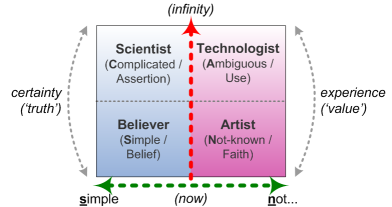In my last post I have started a series about
Power, Process, Project and People. In this post I like to reflect a bit on power and what I am doing with respect to power in my daily Enterprise Architecture life. Just to repeat the definition from the
Oxford Dictionaries:
Power is the ability or official capacity to exercise control; authority. There is of course a lot of other definitions or deeper explanations of this concept. As a starter I recommend to read the
Manifesto reference-sheet from power and response-ability from
Tom Graves. For simplicity reasons I here stick to the very simple above mentioned Oxford Dictionaries definition.

Power is most obviously found in organizations by just looking at the organizational chart. In most cases it is formed like a pyramid with one on the top and some below, which have each some below them again. This can potentially be a very high structure (e.g. CEO > CxO Board > Divisions > Departments > Groups > Employees), even though there is some companies who run a flat hierarchy. In most cases these structures are self defending (
GLUE Division Defence). It is very uncommon to see an Employee who has a higher salary than his manager. Also concepts like a technical career path typically only worsen the situation, because now the employees themselves are organized in a pyramid. And it can all be summed up by the concept of Julius Caesar:
Divide and Conquer, which I have used to introduce the concept of the
GLUE Domains. What I observe most it that it is limiting and framing people into something way smaller than they could be.
The typical advice I hear and read in various Enterprise Architecture Frameworks (e.g.
TOGAF 9) is to place Enterprise Architecture in the governance structure close to the CxO level, preferable reporting direct to the CIO (Enterprise IT Architecture) or to the CEO (Enterprise Architecture). There is also the idea to put it below the CMO (?Enterprise Marketing Architecture?). Even though I have seen a lot of value created at that level I also see a fair amount of disconnect to the employee level and Ivory tower behaviour. The balance between strategy, tactics and operational work is not always easy to keep. And if an Enterprise Architect works only in his power structure then the result will be biased towards exactly that structure, heavily influenced and by that imbalanced due to only staying inside the frames given by it.
So what am I doing different? I am actually using the
GLUE Domains in the GLUE Space to identify and map the power structures. The amount of
GLUE Decks very much depends on the context. For the blog I use four to explain the concept, but it can easily go way higher (or lower).
Typically these Domains are in conflict with each other with respect to
Roles and Responsibilities. For example the responsibility of an Application Owner in the processes of Application Lifecycle Management who owns every aspect of his Application:
And Test Execution, which is typically owned by Test Management. Here two Empires are potentially in conflict.
The (theoretically) simple answer for Enterprise Architecture is now to work close to the decision makers (in this case most likely the CIO) and guide the CIO to take the right decisions. The basic (and I think wrong) assumption behind that is, that the CIO decides and forces it in. Following the basic idea of the power then this is indeed the case and especially and heavy command & control liking environments there is a high likelihood that this will indeed be forced in, because the managers on those structures want to know everything what their people know. I personally believe that this is in most cases causing more damage than it is repairing, therefore I do work different. (
Seth Godin touches this problem in his post
destabilizing the bullying power structure.
I do not need only a strong connection to the decision makers, but I do need to be connected also to the lower levels of the organization. Therefore no framework and no formal governance is enabling me to be an enterprise architect, but
knowing that I am one helps a lot! So instead of relying on pure power structures I go to the people who have the conflict and challenges at hand, and then I am doing Enterprise Architecture work by helping them to connect to the holistic Enterprise (repairing
GLUE Diseases), no matter how deep or high they are on the ladder of power. That of course requires that I have to earn trust first, which is most easily achieved by
walking the talking, especially when the advice is beyond the scope of the power structure.
Feedback as always more than welcome.

















